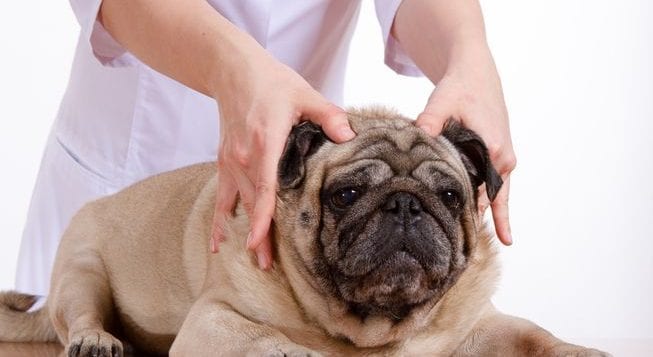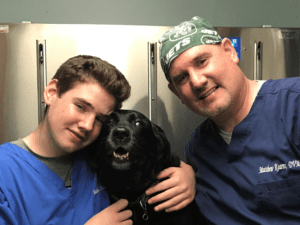By Matthew Kearns, DVM

This past Sunday just before the clinic closed we had a call for a dog that had a laceration she received while running around with her owner. Our clinic is only open a few hours on Sundays and the owner was grateful we could see her and her dog. However, what should she do if we weren’t open until the following day?
Emergency clinics are expensive. Could there be a way to manage the wound until your regular veterinarian opens again? Before proceeding make sure to make your own safety a priority as much as your pet’s. It doesn’t do anyone any good for you to get seriously bit or scratched. When a pet is in pain and afraid, there is the potential for aggression. A leash wrapped around the muzzle prevents biting. Worst case scenario would be placing a thick towel over the pet to prevent biting (even if it is just to take them to the nearest clinic/emergency center).
First, stop the bleeding. If the wound is superficial and there are no larger blood vessels involved, direct pressure is usually enough. I was told in school that singing the “Star Spangled Banner” (either in one’s head or out loud, your choice) while applying pressure to the wound is the appropriate amount of time needed to stop minor bleeding.
During this time it would be a good idea to pet and talk to your pet to calm them and lower blood pressure. After a few minutes recheck the wound. If the bleeding continues, try again. If the bleeding restarts a second time, then do go to the nearest clinic/emergency center.
 Once the bleeding stops we can evaluate and clean the wound. What is safe to use to clean the wound? Running the wound under a hose or tap will remove dirt and other debris. Studies have shown tap water does not cause significant tissue damage when compared to isotonic saline.
Once the bleeding stops we can evaluate and clean the wound. What is safe to use to clean the wound? Running the wound under a hose or tap will remove dirt and other debris. Studies have shown tap water does not cause significant tissue damage when compared to isotonic saline.
If you have an over-the-counter antiseptic like povidone iodine (Betadine) solution even better. Remember to dilute the Betadine solution. The exact appropriate dilution is 1 part Betadine to 9 parts water; but I was told that if the solution has the color of strong tea that is close enough.
Many people ask about hydrogen peroxide solution. I remember that hydrogen peroxide was the “go to” antiseptic when I was a child and got a cut or scratch. It is an excellent antiseptic, but it tends to destroy more tissue and slow the healing process overall. It has also been implicated in the entrance of air emboli into the bloodstream when used to clean deeper wounds or abscesses. These emboli can have serious, sometimes fatal results. If you have no other antiseptic but hydrogen peroxide, then dilute it 50:50 with water.
Lastly, cover the wound. It is true that when a pet licks at a wound it does remove debris and dead tissue, but it also introduces bacteria from the pet’s mouth, which slows or prevents healing. To cover the wound one can use some gauze and an ACE bandage. Now, one can even pick up self-adhesive bandage material from the pharmacy or store. Just remember that the self-adhesive material tends to tighten as it dries out (after it is removed from the packaging).
I hope this helps. Please remember that these are temporary measures to allow you to wait for your regular veterinarian to open. I would recommend always having the wound evaluated by your veterinarian as soon as possible.
Dr. Kearns practices veterinary medicine from his Port Jefferson office and is pictured with his son Matthew and his dog Jasmine. Have a question for Dr. Kearns? Email it to [email protected] to see his answer in an upcoming column.




 I authored an article on the benefits of medical marijuana and the legal restrictions of a veterinarian’s ability to prescribe anything with the psychogenic component of marijuana, tetrahydrocannabinol (THC), back in September of 2018.
I authored an article on the benefits of medical marijuana and the legal restrictions of a veterinarian’s ability to prescribe anything with the psychogenic component of marijuana, tetrahydrocannabinol (THC), back in September of 2018.


 I hope everyone has a joyous and safe holiday season and a Happy New Year. Special thanks to Heidi Sutton and all the staff of the Arts and Lifestyle section for making my column possible and another great year.
I hope everyone has a joyous and safe holiday season and a Happy New Year. Special thanks to Heidi Sutton and all the staff of the Arts and Lifestyle section for making my column possible and another great year.


 I recently had a pet owner come in and ask me if grain-free diets were dangerous. I knew there were risks of bacterial and parasitic contamination in raw diets but had not heard anything about grain-free diets. Time to investigate.
I recently had a pet owner come in and ask me if grain-free diets were dangerous. I knew there were risks of bacterial and parasitic contamination in raw diets but had not heard anything about grain-free diets. Time to investigate. 
 The ear canal contains epithelial cells (those similar to skin), ceruminous cells and apocrine cells (cells that produce earwax). Epithelial cells will turn over, or be replaced every few days and, along with a small amount of earwax, migrate toward the entrance of the canal. Once at the entrance a good shake of the head sends it out to the world. If the lining of the ear canal becomes inflamed, it narrows due to swelling (most likely due to some sort of food or environmental/seasonal allergy) and excessive ear wax is produced. This combination not only overwhelms the ear’s ability to clear the wax, it also leads to a warm, dark and moist environment and allows the normal bacteria and yeast to go crazy.
The ear canal contains epithelial cells (those similar to skin), ceruminous cells and apocrine cells (cells that produce earwax). Epithelial cells will turn over, or be replaced every few days and, along with a small amount of earwax, migrate toward the entrance of the canal. Once at the entrance a good shake of the head sends it out to the world. If the lining of the ear canal becomes inflamed, it narrows due to swelling (most likely due to some sort of food or environmental/seasonal allergy) and excessive ear wax is produced. This combination not only overwhelms the ear’s ability to clear the wax, it also leads to a warm, dark and moist environment and allows the normal bacteria and yeast to go crazy.




